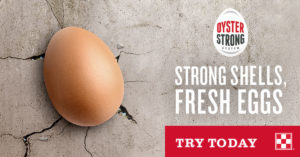 Purina® Layena® and Layena® Plus Omega-3 chicken feed include our exclusive Oyster Strong™ System for strong shells and fresh eggs
Purina® Layena® and Layena® Plus Omega-3 chicken feed include our exclusive Oyster Strong™ System for strong shells and fresh eggs
No Need to Supplement: It’s All in the Bag
Calcium is the number one nutrient for laying hens. For years, there has been only one way to provide this key nutrient: by supplementing layer feed with oyster shells.
Now, Purina® Layena® and Layena® Plus Omega-3 layer feeds include Oyster Strong™ System, an exclusive blend of oyster shell and key vitamins and minerals, like vitamin D and manganese, ensuring a supply of calcium will be available at night when your hens are forming eggs.
Our exclusive Oyster Strong™ System eliminates the need to supplement as all the necessary calcium is included in every bite of our complete layer feed.
https://youtu.be/P0j_5D1WOEM
What is Purina’s Oyster Strong™ System?
Purina’s Oyster Strong™ System is a blend of oyster shell and key vitamins and minerals, like vitamin D and manganese. This combination includes large particles that break down slowly, ensuring that hens receive a supply of calcium at night when they need it most. This slow-release calcium is important for strong shells and healthy hens. It’s included exclusively in Purina® Layena® and Layena® Plus Omega-3 layer feeds.
How does Purina’s Oyster Strong™ System work?
Oyster Strong™ System is made up of larger particle size oyster shell. The large particles break down over time and release calcium slowly.
Here’s why slow-release calcium is important:
– Each eggshell includes about 2 grams of calcium. To form each eggshell, hens must consume about 4 grams of calcium per day through their feed.
– It takes approximately 20 hours for a hen to make an eggshell. Because of this timeframe, much of the work is done overnight – long after the hen has eaten.
– If only a quick-release calcium is provided, the hen would digest it very quickly, leaving a void for the additional calcium she needs while she sleeps.
– If a hen does not have the necessary calcium, she may pull the nutrient from her bones which can cause a weak skeletal structure.
Through the entire egg formation process, hens incorporate nutrients from their feed into the egg and shell. Offering a complete layer feed that includes Purina’s exclusive Oyster Strong™ System, like Layena® or Layena® Plus Omega-3 layer feed, helps you provide all the nutrients your hens need for nutritious eggs, protected by strong shells.
Do I need to supplement my layer feed with oyster shells?
If you are feeding your hens a diet consisting of 90% Purina® Layena® or Layena® Plus Omega-3 layer feed with Oyster Strong™ System, you should not need to supplement with oyster shells. The added calcium is included right in the feed.
Can I feed eggshells to my hens for added calcium?
You can provide egg shells to your hens as a calcium source. Just be aware that there could be some issues with this approach.
– The calcium in eggshells is not as available to the hen as it is from oyster shell and it may break down quicker than the slow-release calcium in Oyster Strong™ System.
– Your birds will need to eat more eggshells to get the same amount of calcium as from oyster shell.
– You could be teaching your birds that eating eggshells is okay, which could lead them to start eating the eggs that they are laying.
– If you decide to offer eggshells, be sure to dry and clean the eggshells prior to giving them to your birds. You could be feeding the hens bacteria that you do not want them to have and could potentially make them sick.
Remember that Oyster Strong™ System is incorporated into both Purina® Layena® and Layena® Plus Omega-3. In most cases, you should not need to supplement oyster shell when you are feeding a complete layer feed that includes Oyster Strong™ System.
When should I start feeding layer feed to my birds?
Start feeding a complete layer feed to your hens when they turn 18 weeks old or when you see the first egg, whichever comes first. Eighteen weeks is the age when most egg-laying breeds are considered adults. Most excitingly, it’s the time when many breeds will lay their first egg. To produce eggs, hens require different nutrients from when they were growing; therefore, at this key milestone, you can start switching your chickens to layer feed.
After choosing a complete layer feed for your flock, it is important to make the transition over time to prevent digestive upset.
For the backyard birds on our farm in Missouri, we have found it’s best to make the transition over time rather than all at once. We mix the starter and layer feed evenly for four or five days. If birds are used to crumbles, start with a crumble layer feed. The same goes with pellets. The more similar the two feeds are, the more smoothly the transition will go.
Many hens will eat the mixed feed without noticing a difference. When hens are eating both feeds, flock owners can stop feeding the starter feed and make the complete switch to all layer feed. It is important to give your birds enough time to adjust to the new diet. Most birds will adjust within a couple of weeks but some can take a month or longer to fully transition to their new diet.




